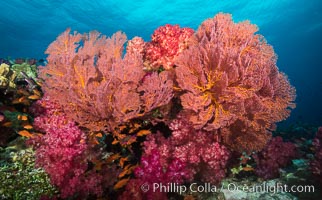
Plexauridae sea fan gorgonian and dendronephthya soft coral on coral reef. Both the sea fan gorgonian and the dendronephthya are type of alcyonacea soft corals that filter plankton from passing ocean currents.
Species: Dendronephthya soft coral, Gorgonian, Sea fan, Dendronephthya, Gorgonacea, Plexauridae
Location: Fiji
Image ID: 31439
Species: Dendronephthya soft coral, Gorgonian, Sea fan, Dendronephthya, Gorgonacea, Plexauridae
Location: Fiji
Image ID: 31439
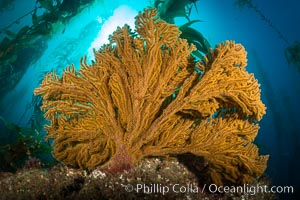
Golden gorgonian on underwater rocky reef, amid kelp forest, Catalina Island. The golden gorgonian is a filter-feeding temperate colonial species that lives on the rocky bottom at depths between 50 to 200 feet deep. Each individual polyp is a distinct animal, together they secrete calcium that forms the structure of the colony. Gorgonians are oriented at right angles to prevailing water currents to capture plankton drifting by.
Species: California golden gorgonian, Muricea californica
Location: Catalina Island, California
Image ID: 34219
Species: California golden gorgonian, Muricea californica
Location: Catalina Island, California
Image ID: 34219
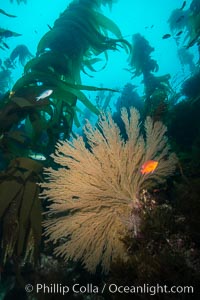
Garibaldi and California golden gorgonian on underwater rocky reef, San Clemente Island. The golden gorgonian is a filter-feeding temperate colonial species that lives on the rocky bottom at depths between 50 to 200 feet deep. Each individual polyp is a distinct animal, together they secrete calcium that forms the structure of the colony. Gorgonians are oriented at right angles to prevailing water currents to capture plankton drifting by.
Species: California golden gorgonian, Garibaldi, Hypsypops rubicundus, Muricea californica
Location: San Clemente Island, California
Image ID: 30864
Species: California golden gorgonian, Garibaldi, Hypsypops rubicundus, Muricea californica
Location: San Clemente Island, California
Image ID: 30864
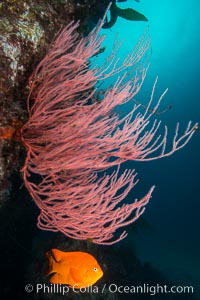
Garibaldi and red gorgonian on rocky reef, below kelp forest, underwater. The red gorgonian is a filter-feeding temperate colonial species that lives on the rocky bottom at depths between 50 to 200 feet deep. Gorgonians are oriented at right angles to prevailing water currents to capture plankton drifting by.
Species: Garibaldi, Red gorgonian, Hypsypops rubicundus, Leptogorgia chilensischilensis, Lophogorgia chilensis
Location: San Clemente Island, California
Image ID: 30870
Species: Garibaldi, Red gorgonian, Hypsypops rubicundus, Leptogorgia chilensischilensis, Lophogorgia chilensis
Location: San Clemente Island, California
Image ID: 30870
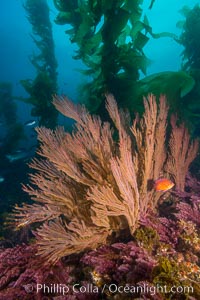
California golden gorgonian on underwater rocky reef below kelp forest, San Clemente Island. The golden gorgonian is a filter-feeding temperate colonial species that lives on the rocky bottom at depths between 50 to 200 feet deep. Each individual polyp is a distinct animal, together they secrete calcium that forms the structure of the colony. Gorgonians are oriented at right angles to prevailing water currents to capture plankton drifting by, San Clemente Island.
Species: California golden gorgonian, Muricea californica
Location: San Clemente Island, California
Image ID: 30909
Species: California golden gorgonian, Muricea californica
Location: San Clemente Island, California
Image ID: 30909
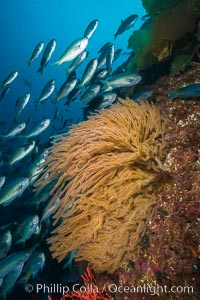
Blacksmith Chromis and California golden gorgonian on underwater rocky reef, San Clemente Island. The golden gorgonian is a filter-feeding temperate colonial species that lives on the rocky bottom at depths between 50 to 200 feet deep. Each individual polyp is a distinct animal, together they secrete calcium that forms the structure of the colony. Gorgonians are oriented at right angles to prevailing water currents to capture plankton drifting by.
Species: Blacksmith, California golden gorgonian, Chromis punctipinnis, Muricea californica
Location: San Clemente Island, California
Image ID: 30956
Species: Blacksmith, California golden gorgonian, Chromis punctipinnis, Muricea californica
Location: San Clemente Island, California
Image ID: 30956
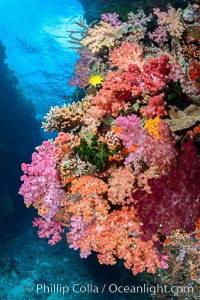
Spectacularly colorful dendronephthya soft corals on South Pacific reef, reaching out into strong ocean currents to capture passing planktonic food, Fiji.
Species: Dendronephthya soft coral, Dendronephthya
Location: Fiji
Image ID: 31442
Species: Dendronephthya soft coral, Dendronephthya
Location: Fiji
Image ID: 31442
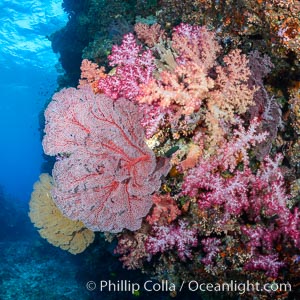
Sea fan or gorgonian on coral reef. This gorgonian is a type of colonial alcyonacea soft coral that filters plankton from passing ocean currents.
Species: Dendronephthya soft coral, Gorgonian, Dendronephthya, Gorgonacea
Location: Fiji
Image ID: 31443
Species: Dendronephthya soft coral, Gorgonian, Dendronephthya, Gorgonacea
Location: Fiji
Image ID: 31443
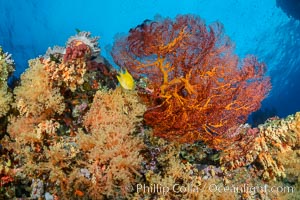
Sea fan gorgonian and dendronephthya soft coral on coral reef. Both the sea fan gorgonian and the dendronephthya are type of alcyonacea soft corals that filter plankton from passing ocean currents.
Species: Dendronephthya soft coral, Gorgonian, Dendronephthya, Gorgonacea
Location: Fiji
Image ID: 31444
Species: Dendronephthya soft coral, Gorgonian, Dendronephthya, Gorgonacea
Location: Fiji
Image ID: 31444
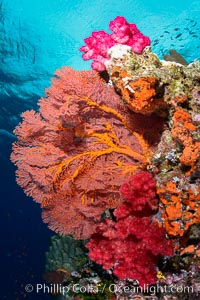
Sea fan gorgonian and dendronephthya soft coral on coral reef. Both the sea fan gorgonian and the dendronephthya are type of alcyonacea soft corals that filter plankton from passing ocean currents.
Species: Dendronephthya soft coral, Gorgonian, Sea fan, Dendronephthya, Gorgonacea, Plexauridae
Location: Fiji
Image ID: 31447
Species: Dendronephthya soft coral, Gorgonian, Sea fan, Dendronephthya, Gorgonacea, Plexauridae
Location: Fiji
Image ID: 31447
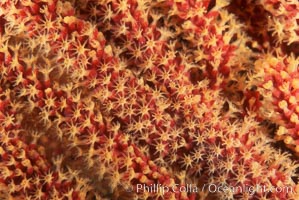
California Golden gorgonian polyps. The golden gorgonian is a colonial organism composed of thousands of tiny polyps. Each polyp secretes calcium which accumulates to form the structure of the colony. The fan-shaped gorgonian is oriented perpendicular to prevailing ocean currents to better enable to filter-feeding polyps to capture passing plankton and detritus passing by.
Species: California golden gorgonian, Muricea californica
Location: San Clemente Island, California
Image ID: 03481
Species: California golden gorgonian, Muricea californica
Location: San Clemente Island, California
Image ID: 03481
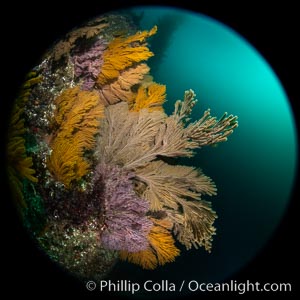
Brown gorgonian and California golden gorgonian on underwater rocky reef below kelp forest, Catalina Island. Gorgonians are filter-feeding temperate colonial species that lives on the rocky bottom at depths between 50 to 200 feet deep. Each individual polyp is a distinct animal, together they secrete calcium that forms the structure of the colony. Gorgonians are oriented at right angles to prevailing water currents to capture plankton drifting by.
Species: Brown gorgonian, California golden gorgonian, Muricea californica, Muricea fruticosa
Location: Catalina Island, California
Image ID: 37292
Species: Brown gorgonian, California golden gorgonian, Muricea californica, Muricea fruticosa
Location: Catalina Island, California
Image ID: 37292
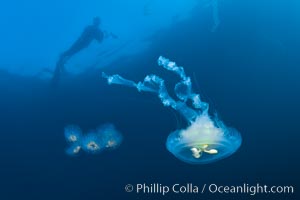
Freediver photographing pelagic gelatinous zooplankton, adrift in the open ocean.
Species: Fried-egg jellyfish, Phacellophora camtschatica
Location: San Diego, California
Image ID: 26817
Species: Fried-egg jellyfish, Phacellophora camtschatica
Location: San Diego, California
Image ID: 26817
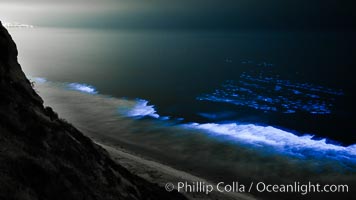
Bottlenose dolphins swim through red tide, hunt a school of fish, lit by glowing bioluminescence caused by microscopic Lingulodinium polyedrum dinoflagellate organisms which glow blue when agitated at night.
Species: Lingulodinium polyedrum
Location: La Jolla, California
Image ID: 27066
Species: Lingulodinium polyedrum
Location: La Jolla, California
Image ID: 27066
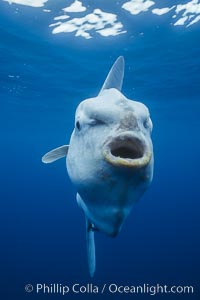
Ocean sunfish (Mola mola) with mouth wide open for slurping zooplankton, open ocean.
Species: Ocean sunfish, Mola mola
Location: San Diego, California
Image ID: 03319
Species: Ocean sunfish, Mola mola
Location: San Diego, California
Image ID: 03319
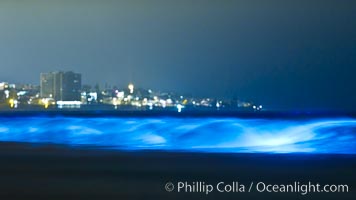
Lingulodinium polyedrum red tide dinoflagellate plankton, glows blue when it is agitated in wave and is visible at night.
Species: Lingulodinium polyedrum
Location: La Jolla, California
Image ID: 27064
Species: Lingulodinium polyedrum
Location: La Jolla, California
Image ID: 27064
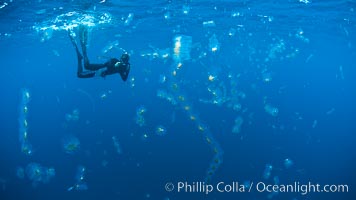
Freediving photographer in a cloud of salps, gelatinous zooplankton that drifts with open ocean currents.
Location: San Diego, California
Image ID: 27012
Location: San Diego, California
Image ID: 27012
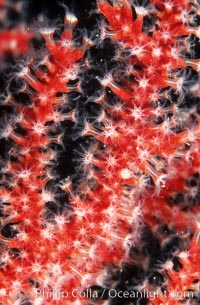
Red gorgonian polyps. The red gorgonian is a colonial organism composed of thousands of tiny polyps. Each polyp secretes calcium which accumulates to form the structure of the colony. The fan-shaped gorgonian is oriented perpendicular to prevailing ocean currents to better enable to filter-feeding polyps to capture passing plankton and detritus passing by.
Species: Red gorgonian, Leptogorgia chilensis, Lophogorgia chilensis
Location: San Clemente Island, California
Image ID: 03480
Species: Red gorgonian, Leptogorgia chilensis, Lophogorgia chilensis
Location: San Clemente Island, California
Image ID: 03480
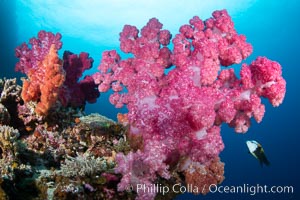
Closeup view of colorful dendronephthya soft corals, reaching out into strong ocean currents to capture passing planktonic food, Fiji.
Species: Dendronephthya soft coral, Dendronephthya
Location: Vatu I Ra Passage, Bligh Waters, Viti Levu Island, Fiji
Image ID: 34780
Species: Dendronephthya soft coral, Dendronephthya
Location: Vatu I Ra Passage, Bligh Waters, Viti Levu Island, Fiji
Image ID: 34780
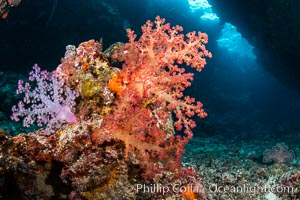
Fiji is the soft coral capital of the world, Seen here are beautifully colorful dendronephthya soft corals reaching out into strong ocean currents to capture passing planktonic food, Fiji.
Species: Dendronephthya soft coral, Dendronephthya
Location: Vatu I Ra Passage, Bligh Waters, Viti Levu Island, Fiji
Image ID: 34783
Species: Dendronephthya soft coral, Dendronephthya
Location: Vatu I Ra Passage, Bligh Waters, Viti Levu Island, Fiji
Image ID: 34783
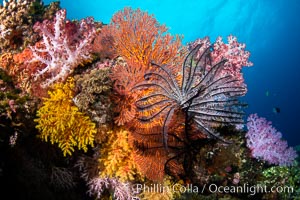
Anthias fishes school over the colorful Fijian coral reef, everything taking advantage of currents that bring planktonic food. Fiji.
Species: Anthias, Dendronephthya soft coral, Dendronephthya, Pseudanthias
Location: Vatu I Ra Passage, Bligh Waters, Viti Levu Island, Fiji
Image ID: 34789
Species: Anthias, Dendronephthya soft coral, Dendronephthya, Pseudanthias
Location: Vatu I Ra Passage, Bligh Waters, Viti Levu Island, Fiji
Image ID: 34789
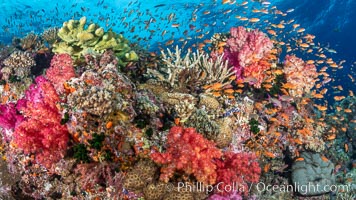
Anthias fishes school over the colorful Fijian coral reef, everything taking advantage of currents that bring planktonic food. Fiji.
Species: Anthias, Dendronephthya soft coral, Dendronephthya, Pseudanthias
Location: Bligh Waters, Fiji
Image ID: 34792
Species: Anthias, Dendronephthya soft coral, Dendronephthya, Pseudanthias
Location: Bligh Waters, Fiji
Image ID: 34792
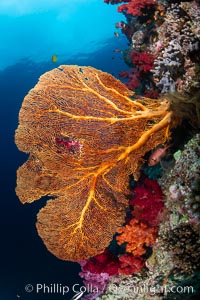
Plexauridae sea fan or gorgonian on coral reef. This gorgonian is a type of colonial alcyonacea soft coral that filters plankton from passing ocean currents.
Species: Gorgonian, Gorgonacea
Location: Gau Island, Lomaiviti Archipelago, Fiji
Image ID: 34797
Species: Gorgonian, Gorgonacea
Location: Gau Island, Lomaiviti Archipelago, Fiji
Image ID: 34797
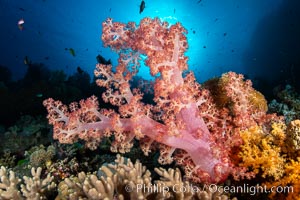
Closeup view of colorful dendronephthya soft corals, reaching out into strong ocean currents to capture passing planktonic food, Fiji.
Species: Dendronephthya soft coral, Dendronephthya
Location: Fiji
Image ID: 34801
Species: Dendronephthya soft coral, Dendronephthya
Location: Fiji
Image ID: 34801
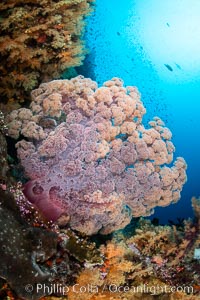
Fiji is the soft coral capital of the world, Seen here are beautifully colorful dendronephthya soft corals reaching out into strong ocean currents to capture passing planktonic food, Fiji.
Species: Dendronephthya soft coral, Dendronephthya
Location: Vatu I Ra Passage, Bligh Waters, Viti Levu Island, Fiji
Image ID: 34814
Species: Dendronephthya soft coral, Dendronephthya
Location: Vatu I Ra Passage, Bligh Waters, Viti Levu Island, Fiji
Image ID: 34814
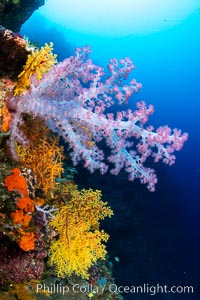
Fiji is the soft coral capital of the world, Seen here are beautifully colorful dendronephthya soft corals reaching out into strong ocean currents to capture passing planktonic food, Fiji.
Species: Dendronephthya soft coral, Dendronephthya
Location: Vatu I Ra Passage, Bligh Waters, Viti Levu Island, Fiji
Image ID: 34829
Species: Dendronephthya soft coral, Dendronephthya
Location: Vatu I Ra Passage, Bligh Waters, Viti Levu Island, Fiji
Image ID: 34829
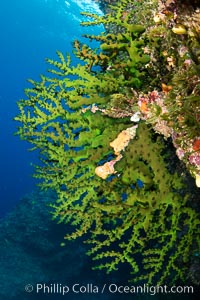
Green fan coral, extending into ocean currents where tiny polyps gather passing plankton, Fiji.
Location: Vatu I Ra Passage, Bligh Waters, Viti Levu Island, Fiji
Image ID: 34830
Location: Vatu I Ra Passage, Bligh Waters, Viti Levu Island, Fiji
Image ID: 34830
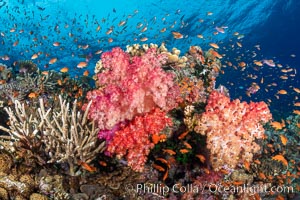
Anthias fishes school over the colorful Fijian coral reef, everything taking advantage of currents that bring planktonic food. Fiji.
Species: Anthias, Dendronephthya soft coral, Dendronephthya, Pseudanthias
Location: Bligh Waters, Fiji
Image ID: 34832
Species: Anthias, Dendronephthya soft coral, Dendronephthya, Pseudanthias
Location: Bligh Waters, Fiji
Image ID: 34832
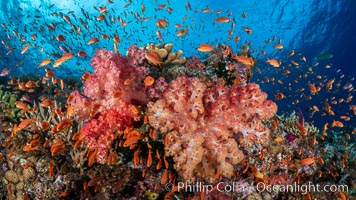
Anthias fishes school over the colorful Fijian coral reef, everything taking advantage of currents that bring planktonic food. Fiji.
Species: Anthias, Dendronephthya soft coral, Dendronephthya, Pseudanthias
Location: Bligh Waters, Fiji
Image ID: 34836
Species: Anthias, Dendronephthya soft coral, Dendronephthya, Pseudanthias
Location: Bligh Waters, Fiji
Image ID: 34836

Spectacularly colorful dendronephthya soft corals on South Pacific reef, reaching out into strong ocean currents to capture passing planktonic food, Fiji.
Species: Dendronephthya soft coral, Dendronephthya
Location: Nigali Passage, Gau Island, Lomaiviti Archipelago, Fiji
Image ID: 34839
Species: Dendronephthya soft coral, Dendronephthya
Location: Nigali Passage, Gau Island, Lomaiviti Archipelago, Fiji
Image ID: 34839